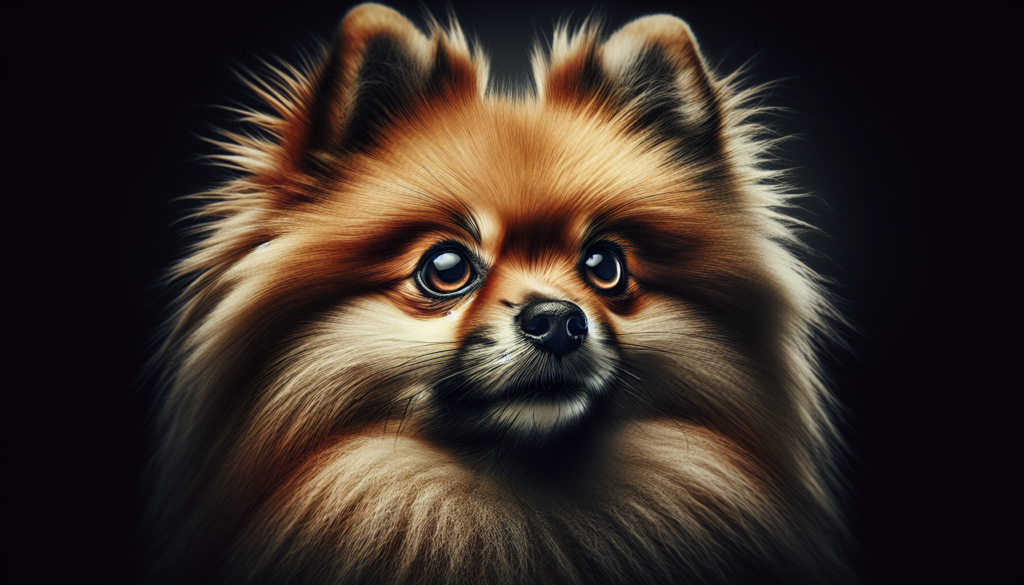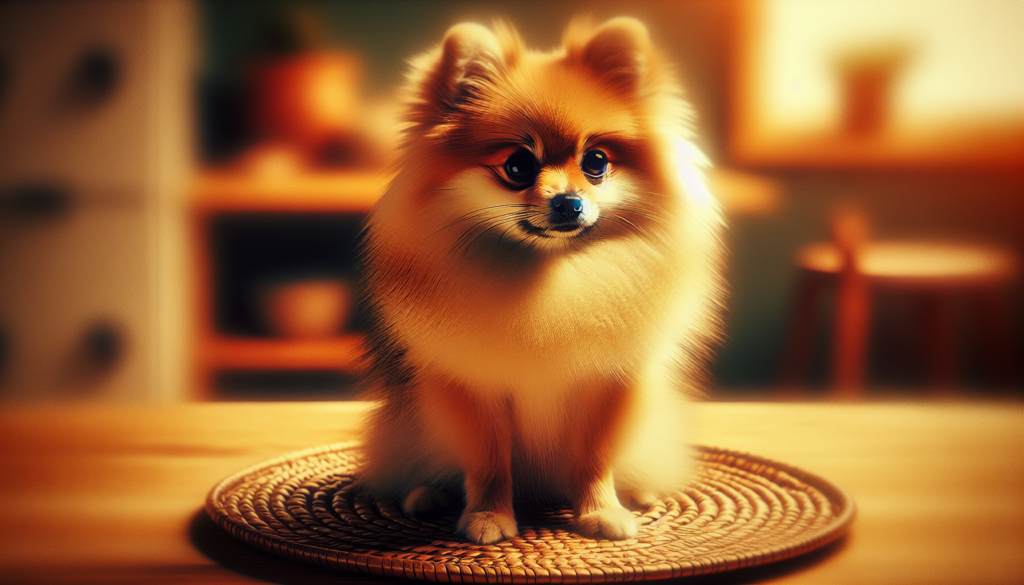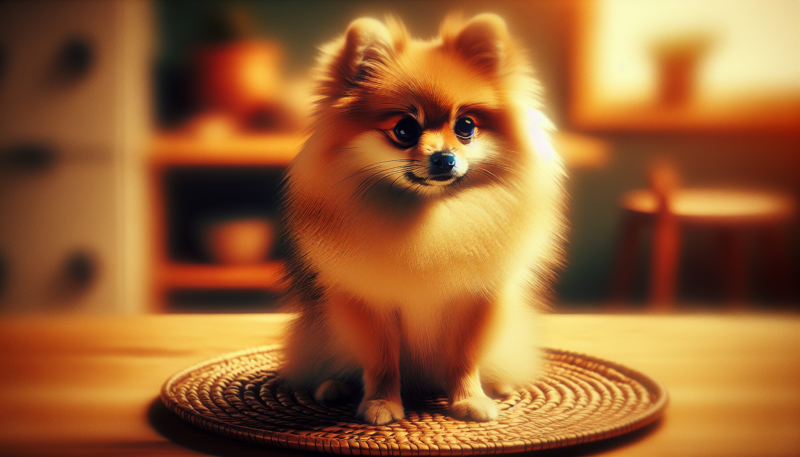Picture this: you’re lounging on your couch, enjoying a quiet evening at home when suddenly the doorbell rings. Instantly, your furry little companion jumps off your lap and races towards the door, barking with all their might. It’s incredible how such a small creature can possess such fierce protectiveness. In this article, we’ll explore the intriguing world of Pomeranians and their innate protective instincts. Whether it’s their strong bond with their owners or a result of their breed’s history, we’ll uncover the reasons behind these pint-sized guardians. So, grab a cup of tea and get ready to delve into the fascinating world of the protective instincts of Pomeranians.

The History and Background of Pomeranians
Origins from larger sled dog breeds
Pomeranians, despite their small size and adorable appearance, actually have a fascinating history that traces back to larger sled dog breeds. Originally, Pomeranians were bred from working dogs in the Arctic region, such as the Samoyed and the Norwegian Elkhound. These sled dogs were known for their strength, endurance, and ability to withstand harsh climates.
The breed’s royalty connections
As the breed developed, Pomeranians caught the attention of European nobility, particularly during the time of Queen Victoria in the 19th century. Queen Victoria played a significant role in popularizing the breed, as she became an ardent enthusiast of Pomeranians and was often seen with her beloved dogs.
Transition into toy-sized companions
Over time, breeders selectively bred Pomeranians to be smaller in size, transitioning them into toy-sized companions. By the early 20th century, Pomeranians had shed their working dog heritage and became sought-after as fashionable companion pets. Today, we recognize Pomeranians for their petite stature, luxurious coats, and captivating personalities.
Understanding Pomeranian Temperament
Friendly and extroverted nature
One of the most endearing traits of Pomeranians is their friendly and extroverted nature. They love companionship and thrive in social environments. Pomeranians are known to be quite outgoing and enthusiastic, always eager to interact with their owners and other people. Their charming demeanor makes them fantastic pets for families and individuals alike.
Lively and playful disposition
Pomeranians have a lively and playful disposition that brings joy and entertainment to any household. With abundant energy and a zest for life, these little dogs are always ready for a good romp or a spirited game. Whether engaging in fetch, playing with toys, or simply chasing their tails, Pomeranians never fail to bring smiles and laughter to those around them.
Tendency to be wary of strangers
Despite their friendly nature, Pomeranians do tend to be wary of strangers. This wariness stems from their protective instincts, as they feel responsible for guarding their owners and their territory. Pomeranians may exhibit some aloofness or alertness when encountering unfamiliar individuals, but with proper socialization, this behavior can be managed effectively.
The Protective Instincts of Pomeranians
Instinctual role as a companion and watchdog
Pomeranians have a natural instinct to fulfill both the roles of a companion and a watchdog. This is a result of their historical background as working dogs and their close bond with their owners. They are attentive and sensitive to their surroundings, always vigilant to potential threats. Pomeranians take their role of protecting their owners seriously and will sound the alarm when they perceive a potential danger.
Small size and alertness as a deterrent
Despite their small size, Pomeranians possess a remarkable ability to deter potential intruders or threats. Their alertness coupled with their vocal nature makes them an effective alarm system. When faced with a stranger or suspicious activity, Pomeranians will not hesitate to bark loudly to alert their owners and deter any potential wrongdoers.
Loyal and devoted nature towards their owners
Pomeranians are known for their loyalty and devotion to their owners. They form strong bonds and consider themselves an integral part of their family. This loyalty manifests in their protective instincts, as they will go to great lengths to defend and safeguard their loved ones. Pomeranians are fiercely devoted and will always prioritize the safety and wellbeing of their owners.
Factors Influencing Pomeranian’s Protective Behavior
Early socialization and training
Early socialization and training play a crucial role in shaping a Pomeranian’s protective behavior. Exposing them to various people, animals, and environments during their formative months helps them develop confidence and learn appropriate responses. Positive experiences during socialization create a well-rounded Pomeranian who understands when protective behavior is necessary and when it is not.
Owner’s characteristics and environment
A Pomeranian’s protective behavior can also be influenced by the characteristics and behavior of their owners. Dogs are intuitive creatures and can sense their owner’s emotions and reactions. If an owner displays fear or anxiety, the Pomeranian may interpret this as a potential threat and respond protectively. Additionally, the environment in which the Pomeranian resides, such as living in a high-crime area or a secluded property, can also impact their level of protectiveness.
Pomeranian’s individual personality traits
Just like humans, each Pomeranian has their own unique personality traits. Some Pomeranians may naturally possess a more protective disposition, while others may be more laid-back. Understanding and appreciating these individual traits are essential in managing their protective behavior. Owners should tailor their training and socialization efforts to suit their Pomeranian’s specific needs and temperament.

Signs of Protective Behavior in Pomeranians
Barking and growling at perceived threats
One of the most common signs of protective behavior in Pomeranians is barking or growling at perceived threats. When they sense danger or an unfamiliar person, Pomeranians will vocalize their concerns to alert their owners. This vocalization serves as both an alarm and a deterrent to potential threats.
Alertness and attentiveness towards potential dangers
Pomeranians are constantly on the lookout for potential dangers. Their alertness and attentiveness towards their surroundings allow them to quickly identify any unusual or suspicious activity. This heightened awareness is a key indicator of their protective instincts kicking in.
Possessiveness and resource guarding tendencies
In some cases, Pomeranians may exhibit possessive behavior or resource guarding tendencies as a protective measure. This can manifest in growling or snarling when someone approaches their toys, food, or favorite spots. It is crucial for owners to establish boundaries and teach their Pomeranians appropriate behavior in these situations.
Common Triggers for Protective Reactions
Approaching strangers or unfamiliar animals
Pomeranians are more likely to display protective reactions when strangers or unfamiliar animals approach their owners or their territory. They may bark, growl, or exhibit signs of warning in an attempt to deter potential threats.
Protecting their territory or belongings
Pomeranians are naturally territorial and may become protective when they perceive their territory, such as their home or yard, is being encroached upon. They consider their belongings, such as toys or beds, as part of their territory and may show possessive behavior when they feel their belongings are under threat.
Feeling threatened or cornered in certain situations
Pomeranians may also exhibit protective behavior when they feel threatened or cornered in certain situations. For example, if they are approached too quickly or handled roughly by someone they do not trust, they may react defensively to protect themselves.
Managing and Modifying Protective Instincts
Proper socialization from a young age
Proper socialization is key in managing and modifying a Pomeranian’s protective instincts. Expose them to a variety of people, animals, and environments in a positive and controlled manner. This helps them become well-rounded and confident dogs who can distinguish between genuine threats and non-threatening situations.
Positive reinforcement training techniques
Positive reinforcement is an effective training technique for managing and modifying a Pomeranian’s protective behavior. Rewarding desired behaviors and redirecting unwanted behaviors helps them understand what is expected of them while maintaining their trust and respect.
Providing mental and physical stimulation
Ensuring that Pomeranians receive adequate mental and physical stimulation can also help manage their protective instincts. Engage them in interactive play, provide them with puzzle toys, and take them on regular walks or outings. A stimulated and well-exercised Pomeranian is less likely to exhibit excessive protective behavior.
Potential Challenges of Overprotective Pomeranians
Potential aggression towards guests or other animals
Overprotective Pomeranians may display aggression towards guests or other animals as they perceive them as potential threats. This aggressive behavior can pose challenges in social situations and may require additional training and management to prevent any harm or discomfort to others.
Difficulty in handling and managing their protective behaviors
Handling and managing the protective behaviors of a Pomeranian can be challenging, especially if their instinctual responses are extreme. Owners must be knowledgeable and well-prepared to address and redirect their Pomeranian’s protective tendencies effectively.
Impact on the Pomeranian’s overall quality of life
An overprotective Pomeranian can experience a diminished quality of life if their behavior limits their ability to interact positively with others or enjoy various activities. It is essential for owners to strike a balance between nurturing their protective instincts and ensuring they can still lead a fulfilling and enriched life.
Seeking Professional Help and Advice
Consulting a certified dog behaviorist
If an owner is struggling with managing their Pomeranian’s protective instincts, it may be beneficial to consult a certified dog behaviorist. These professionals specialize in understanding and modifying dog behavior, including protective behavior. They can provide tailored guidance and support to address any specific challenges.
Joining training or obedience classes
Joining training or obedience classes can also be beneficial in managing a Pomeranian’s protective instincts. These classes provide structured environments where owners and their Pomeranians can learn and practice appropriate socialization and obedience skills under the guidance of experienced trainers.
Utilizing online resources and forums for guidance
For owners looking for additional resources and guidance, online platforms, such as forums and websites dedicated to dog training and behavior, can be valuable sources of information. These platforms allow owners to connect with other Pomeranian owners and professionals who can offer advice and share personal experiences.
Conclusion
Pomeranians, with their rich history and protective instincts, bring a unique and wonderful dynamic to their owners’ lives. Understanding and appreciating their protective behaviors is essential for responsible ownership. With proper socialization, positive reinforcement training, and a nurturing environment, Pomeranians can fulfill their roles as both loving companions and dutiful protectors. As you embark on your journey with a Pomeranian, embrace the joys of their loyal and protective nature, and cherish the invaluable bond you will develop.
